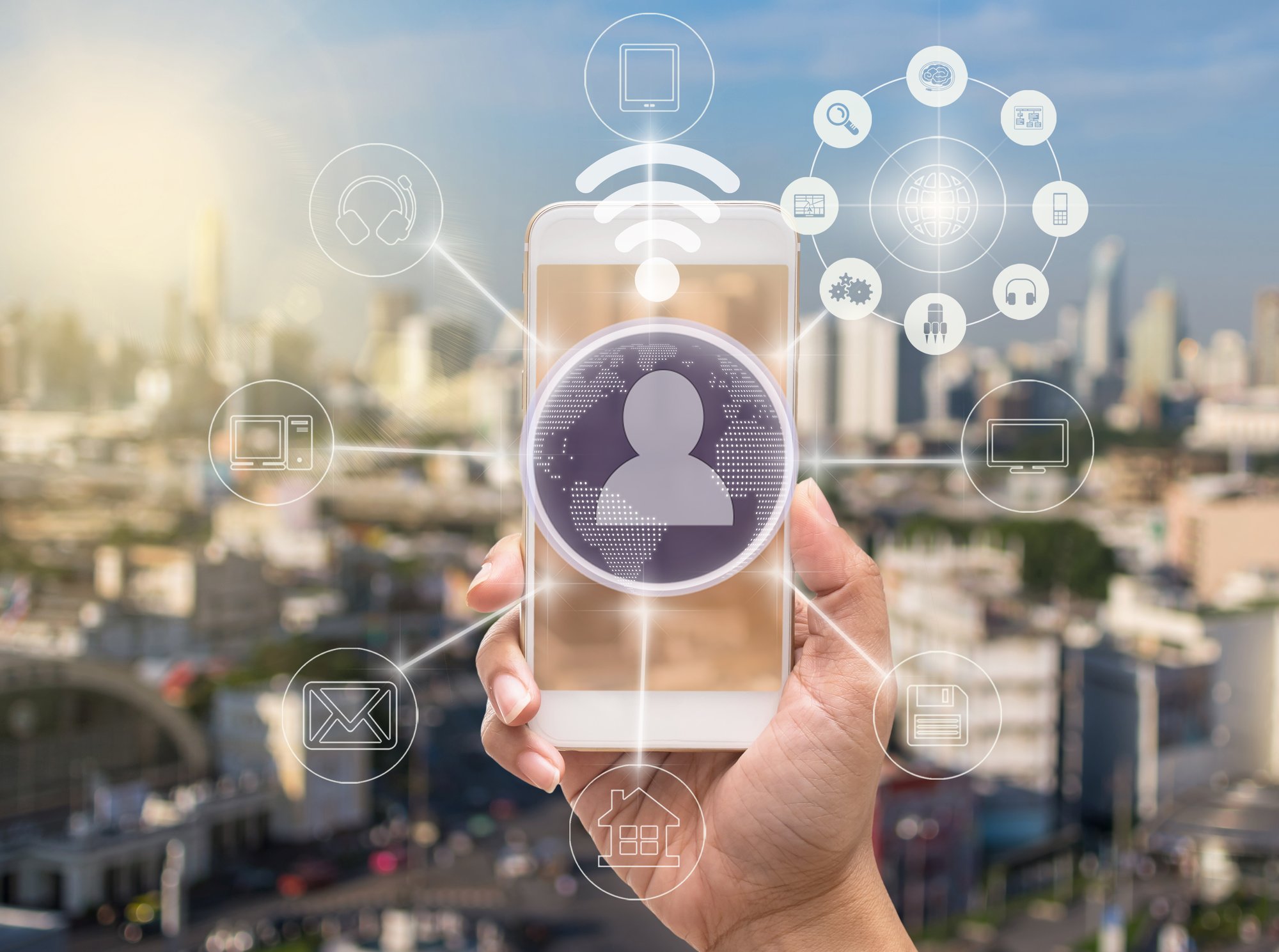Healthcare and Mobility: What Executives Need to Know
A Strong Mobile Strategy

The Apple App store began in 2008 with 500 applications and now contains over 2.2 million apps that have been downloaded over 130 billion timesi . For Android, the Google Play store has similar numbers with over 2.7 million apps and over a hundred billion downloadsii .
Mobile apps give users capabilities ranging from banking and commercial transactions to mapping and geolocation services to social media. Mobile apps have become the consumer’s new normal, and are the platform for the vast majority of customer internet use and interaction. Organizations that offer capabilities and conveniences through this platform are rapidly gaining customer satisfaction and loyalty at the expense of those who do not. Some industries have jumped on the mobility bandwagon more quickly than others. Banking and finance, retail, entertainment, hospitality, social media, and others are building whole new business models based on mobile applications. In contrast, the healthcare industry has been busy with the primary mission of saving lives and improving the quality and efficiency of healthcare while simultaneously having to react to rapidly changing regulations and payment and reimbursement models. As a result, the mobile customer experience hasn’t been the priority in healthcare it has been in other industries.
But now there are so many improvements in patient health and care delivery efficiency that can be realized using mobile, that a strong overall mobile strategy is no longer optional and must be a top priority for any healthcare organization.
A Successful Mobile Strategy

1) Provide a variety of services.
For providers: access to a patient’s clinical records and health information across delivery channels and teams, care team coordination, scheduling, messaging, hospital wayfinding, and real-time access to patient vitals and health indicators.
For payers: claims and claims payment information, coverage and benefits information and customer service, ID cards, network access information, payment estimators, patient care program membership and compliance.
For pharma/drug stores: prescription lists and history by family member across pharmacy brands and outlets, refills and tracking, and loyalty programs
2) Offer comprehensively tested and stable mobile applications that are easy to use.
The demographic cohort that consumes the most healthcare (age 65+) is also the least familiar and comfortable with mobile devices and apps. A successful mobile strategy ensures that apps are easy to use, reliable, secure, and support patients with special needs.
3) Engage the customer and improve their experience with your organization.
Mobile engagement must deliver added value to the customer and not be just another marketing channel. Immediate value drivers include appointment scheduling, health information viewing, prescription renewals, and easy provider locating.
4) Adopt the mobile experience as a critical strategic asset of your organization.
Just as mobile must be integral to the customer experience, it must be central to the business and clinical strategy of the organization. Consider how mobile apps, telemedicine and remote monitoring allow clinical staff to both increase the quality of care delivered and the number of patients served.
Why the Urgency?

Key observations include:
- Your customer’s expectations for mobile experience are the applications on your phone right now. You’re being judged against Amazon and Facebook and Google, not the websites of other providers.
- Healthcare is behind and the winners will be the organizations that close the gap quickly.
- Consumers spend more time on mobile apps than browsing the internet or watching TViii
- 77% own a smart phone, up from 35% just six years agoiv
- 51% own a tablet
- Smartphone/tablet ownership is growing significantly even in the 65+ age group, with 42% now owning a smartphone. The percentage in this group has more than doubled over just the last two years.vi
- The healthcare market is focusing sharply on quality outcomes and cost savings. Cost pressures are increasing at the same time that reimbursements are being tied to clinical outcomes and customer satisfaction.
Use of Mobile Apps by Healthcare Segment
A June 2017 study of the iTunes App store for the 100 largest hospitals by beds,the 100 largest payers by revenue and the 100 largest banks by revenue in theUS produced the following results:
- For this study, an organization was scored “Yes” for any mobile application in the iTunes app store – many providers have an EHR mobile access only and no other mobile features available
- One in four of the 200 largest providers and payers do not offer a mobile application, and of the 76% that do the wide distribution of application maturity is significant
- These results highlight the significant upside in the healthcare mobility market, and illustrate what a long way there is to go to catch up with other industries
- Only 11% of providers offer the three things consumers want most – EHR access, scheduling and provider messaging/ prescription refillsvii
- Lack of patient engagement in this area could cost each of the surveyed hospitals $100 million in revenue on an annual basisviii
Why Mobile Excellence?
- The quality and variety of mobile services offered is becoming a market differentiator.
- Eight in ten Americans have a smartphone. Their service expectations are high and increasing daily.
- The winners in healthcare over the next three years will be those organizations that, at a minimum, can define and meet customer applications with an easy-to-use and stable mobile application.
- The healthcare market is evolving at the most rapid pace in the industry’s history - successful organizations will be the ones that embrace mobile and digital first strategies going forward.
- Digital services, channels and processes are combining with advanced healthcare analytics to enable new operating models in the payer, provider, life sciences and healthcare technology segments. The right mobile strategy includes the agility to adapt to new advances quickly.
Where Are You Now?

RCG’s mobility clients include industry leaders in healthcare, entertainment, financial services, hospitality and gaming. RCG services provided include business and technical strategies, traditional and mobile application development, testing and application maintenance and operations.
Based on these deep and extensive experiences, RCG has defined several attributes that help assess if an organization is on the road to “mobile excellence” or whether they are “trailing and need to play catch up”.
Our most successful clients share the following in their mobility approaches:
- Customer engagement goals and priorities are tightly defined providing a clear definition of what are they are trying to achieve with mobility
- Mobile development and testing are integrated with one another as well as with traditional application work. All development work is done with agility and speed by dedicated teams experienced in both healthcare and technology
- Executives and business area owners are aligned across four primary areas:
Business Requirements & Strategies Understand business needs
Derive & understand critical success measures
Customer Segmentation Understand customer needs in context of the business
Develop and document profiles for customers
Understand customers’ expectations of service levels
Business Applications Review Map business applications to requirements
Map customer profiles to applications
Mobility Capability Define mobility capability requirements
Prioritize lists of features, functions and capabilities
- Business and IT are aligned in three primary technical areas
Platforms Platforms are aligned with mobility capabilities
No platform gaps are eliminated or mitigated
Mobility Strategy Mobility roadmap for the enterprise is documented
Projects are planned and prioritized for ongoing success
Technical Roadmap Mobile strategy is mapped against technical requirements
Investment in mobile resources is committed
Next Steps

If you have a successful mobile strategy, with reliable and easy to use apps that your customers use to engage with your organization, and with a sustainable team and process for keeping up with the state of the art, that’s great! Keep doing what you’re doing while considering how to leverage your investment and how to accelerate your development as new tools and technologies become available.
If instead, you’re uncertain of the right goals and approaches to use mobile to increase your customer engagement, or your business and technical groups are not aligned on a common strategy and plan, or you’re not clear on how to even construct a mobility roadmap, you need to start immediately.
Some steps to take include:
- Assess and Strategize
- Determine your current state against a mobility framework (see RCG sample below)
- Evaluate any current applications
- What goals are they seeking to serve?
- How many patients or members are using them?
- What mobility metrics does the organization have in place?
- Quickly lock down the organization’s priority consumer engagement goals – this is defining “what success looks like”
- Lock in your interim mobility strategy including services and priority channels by segment (include a plan to review/reset the strategy every 6-12 months)
- Revise Architecture and Implementation Approaches
- Update and revise business and technical architectures to align with the interim strategy
- Perform Mistake Free Catchup and Sustainment
- Integrate your application development and testing approaches
- Leverage available internal and external resources as much as possible
End Notes
i https://en.wikipedia.org/wiki/App_Store_(iOS)
ii https://en.wikipedia.org/wiki/Google_Play
iii Lipsman, A., “Major Mobile Milestones in May: Apps Now Drive Half of All Time Spent on Digital,” comScore (June 25, 2014)
iv Pew Research Center 1/12/17 Mobile Fact Sheet
v Pew Research Center 1/12/17 Mobile Fact Sheet
vi Pew Research Center 1/12/17 Mobile Fact Sheet
vii Accenture Consulting, ”Losing Patience: Why Healthcare Providers Need to Up Their Mobile Game”, 2015
viii https://www.nuemd.com/news/2016/03/02/new-study-just-2-percent-us-patients-using-hospitalapps
Download a PDF version of this whitepaper by filling out this form

The customer service experience that your business provides can be the difference between brand loyalty and lost business. But with human agents now competing with AI machines, it can be difficult to interact as efficiently. So how can you leverage AI to make your customers feel heard and valued?
Dr. Rob Nelson, RCG Global Services
